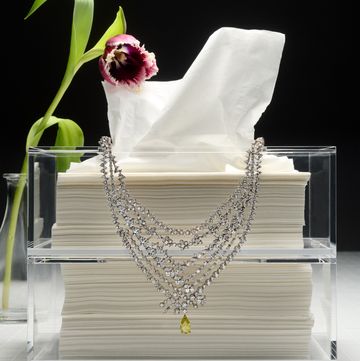What happens right after you open a brand-new skincare product? If it’s a moisturizer, you touch it, smell it, and experience the texture before slathering it on. Is it balmy and thick? Creamy like pudding? A milky lotion? And how does it feel on your face? Is it sticky, goopy, heavy, or greasy? Obviously, our sense of touch provides an essential, reflexive connection between our skin and the brain—a way of delivering important information like Ouch, that’s hot! or Yuck, did I just smear lard on my face?
This sensual, tactile experience is much more than a pickiness issue: The feel-good factor can determine how much of a product you’ll put on, or if you’ll even use enough to reap the benefits. It’s part of the reason so many women skip heavier sunscreen formulas: “People will put a product on their hand first. If they hate how it feels, they won’t use it,” says Dr. Ellen Marmur, New York dermatologist and associate clinical professor at The Mount Sinai Hospital. “That sensory input is the secret to compliance in using a medication or any skincare product and a huge part of efficacy in treating skin conditions such as acne and rosacea. An elegant formula improves the patient’s experience so she’ll actually use it.” Applying a product that you love increases its skincare benefits, simply because you’re putting on enough of it every night.
This fact alone explains why skincare giants from Shiseido to Olay are scrutinizing the latest studies on touch and its neurophysiological effects, employing neuroscientists in their labs, and even crowdsourcing data to help develop new product textures meant to enhance the user experience. Sensory research has suggested that we form confident impressions of products simply by touching them. Shiseido’s behavioral scientists discovered that when people physically touch and smell a beauty product, blood flows to the brain and stimulates brain activity. Even the design of a package can influence our perception of what’s inside. In one study, people said that water seemed to taste better when it was in a firm bottle, as opposed to a flimsy one. The packaging of Shiseido’s new Essential Energy line was inspired by traditional Japanese raku pottery—as well as some extensive psychological metrics. The brand’s researchers found that the unique shape of objects that fit comfortably in your hand, like a handcrafted tea bowl, for instance, brings a feeling of warmth and comfort. And who wouldn’t want what’s inside that jar? Those associative emotional links between the skin (and the thousands of touch receptors in our hands) and the brain pack quite a punch.
Consumer research has also gone high-tech. Olay’s online Skin Advisor tool uses technology rooted in artificial intelligence to analyze your skin. After you’ve uploaded a selfie, your face is compared to a database of more than 50,000 other faces. An algorithm estimates your skin’s perceived age, and then the site provides appropriate product recommendations. Skin Advisor also collects consumer data from more than 2 million people to help drive the invention of game-changing new formulations. For instance, analysts found that 64 percent of the users preferred a lightly hydrated skin feel from their moisturizer, as opposed to that of a richer consistency.
Two other important influences driving these trending textures: Millennials and K-beauty. “A lot of Asian moisturizing products tend to be water thin or fluffy light,” says Toronto-based cosmetic chemist Stephen Alain Ko, “perhaps because it can get so humid in South Korea, or because you can layer more of these on your face in a multiple-step routine. In America, we’re starting to become open to more of these innovative moisturizers.” New York–based dermatologist Dr. Joshua Zeichner thinks the under-30 crowd is at the forefront of the movement: “Younger women are aware of antiaging and want to prevent future wrinkles, but they’re more concerned about clogging their pores and breaking out with some heavy cream or a sticky sunscreen.” With scales tipping so far in the direction of lighter textures, it’s not surprising that suddenly there seems to be no dearth of new skincare products that hit a lighter note: Dior has a “sorbet” cream, Julep has a “pressed”serum, Olay’s new moisturizer is “whipped,” and Tula’s new hydrator is even described as “kefir.”
Maybe it’s because names like these remind women of another attractive texture: silk. “We asked multiple focus groups of women indifferent countries how they would want their faces to feel after putting on moisturizer, and the majority chose a particular type of smooth silk fabric,” explains Frauke Neuser, Ph.D., principal scientist at Olay’s labs in Cincinnati. They then used a futuristic biosensor device called a Syn-Touch (which looks and acts like a human fingertip) to evaluate the tactile properties of the fabric, and, in true Blade Runner fashion, applied their findings in order to help develop the product texture of the new Olay Whip collection, a line of six gossamer-light moisturizers that give you that gold standard silky feel and provide serious skincare benefits at the same time.
That said, this new wave of weightless textures—everything from bouncy jellies to mousse-y whips—may be light as air, but can they really be as hydrating and effective as traditionally heavier creams? For years,we’ve been taught that only a thick cream or ointment can occlude the skin in order to lock in moisture—basically creating another barrier over the surface with thick emollients like lanolin or petrolatum. “As technology and chemistry have evolved, we’re flipping this concept on its head by developing formulas that can enhance absorption without the bulky vehicle,” explains New York–based dermatologist Dr. Kavita Mariwalla. Ko agrees:“Breakthrough formulations, like nano- and micro-emulsions of retinoids, can break down the particle sizes of ingredients and use encapsulation techniques that can work even better than a traditional ointment.” Beauty brands are follow-ing suit, developing ultra lightweight moisturizers that work as well as an occlusive cream. Instead of heavy emollients, Peter Thomas Roth Water Drench Hyaluronic Cloud Cream uses multiple molecular sizes of hyaluronic acid to better penetrate the top layers of the skin, as opposed to sitting on top of it like a raincoat. Tatcha The Water Cream and Shiseido’s new Essential Energy Moisturizing Gel Cream encapsulate moisturizing ingredients in micro-size water balloons that burst open upon application, flooding the skin with hydration. Olay used another unique delivery system to create its airy Whips: Starch-based polymers act like microscopic sponges in the emulsion to soak up moisturizing ingredients like water, niacinamide, and glycerin. When the mesh-like formula touches your skin, it interacts with the natural salts on top to release the encapsulated hydrators. Not to mention that three out of six of Olay’s Whip moisturizers have broad-spectrum SPF 25, so now you have no excuse not to slather it on.
Mission accomplished. The marriage of science and beauty provides myriad moisturizer options that truly deliver the goods, but lest you think these groundbreaking advances are making traditional creams a thing of the past, think again: “Creams aren’t going anywhere,” says Marmur, “because they work so well, and many women love them. It’s just that now we have many other sophisticated textures to choose from—and they’re just as effective.” Amid such a thrilling array of new and delicious-sounding airy whips and mousses, there’s always room for a classic pot de crème. Just do what feels right.
This article originally appears in the March 2018 issue of ELLE.
















